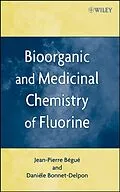* Provides a thorough overview of the role of fluorine in pharmaceutical science and development
* Includes chapters on fluorinated analogues of natural products, fluorinated amino acids and peptides, and derivatives of sugars
* Classifies marketed and in-development fluorinated pharmaceuticals according to their therapeutic classes
Autorentext
Jean-Pierre Begue, PHD, is Emeritus Director of Research at the Centre National de la recherche Scientifique (CNRS) in France. Danièle Bonnet-Delpon, PHD, is Director of Research at CNRS. The authors and their coworkers have developed the chemistry of fluorinated compounds, from organic synthesis to medicinal chemistry.
Klappentext
The diverse applications of fluorine in bioorganic and medicinal chemistry
The discovery of fluorouracil, fluorocorticoids, and fluoroquinolones has led to expanded interest in and usage of fluorine in chemistry. The first comprehensive reference dedicated to detailing the influence of fluorine on the structural properties of a molecule and on a molecule's biological behavior, Bioorganic and Medicinal Chemistry of Fluorine uses examples of fluorinated drugs to provide a thorough overview of the role of fluorine in pharmaceutical science and development. Covering established drugs as well as innovative and promising ideas, it includes:
-
An introduction to the structural, physical, and chemical properties of fluorinated compounds and their preparations
-
An examination of fluorinated analogues of natural products, fluorinated amino acids and peptides, and saccharidic derivatives
-
A discussion of the inhibition of enzymes by fluorinated compounds
-
An overview of existing fluorinated pharmaceuticals as well as some in development, categorized according to their therapeutic classes
Complete with references for further study, this is the premier resource on fluorine for pharmaceutical and medicinal chemists in academia and industry, researchers in organic chemistry and biochemistry, and advanced students and educators in pharmaceutical and medicinal chemistry, biochemistry, and organic chemistry.
Inhalt
Foreword.
Preface to the English Edition
1 General Remarks on Structural, Physical, and Chemical Properties of Fluorinated Compounds.
1.1 Structural Effects.
1.2 Physical Properties.
1.2.1 Boiling Point.
1.2.2 Surface Tension and Activity.
1.2.3 Polarity-Solubility.
1.2.4 Lipophilicity.
1.3 Effects on Electronic Properties and Reactivity.
1.3.1 Effects of Fluorination on Bond Energies and Reactivity.
1.3.2 Effects of Fluorination on the Electronic Repartition of a Molecule.
1.3.3 Acidity, Basicity, and Hydrogen Bond.
1.3.4 Steric Effects.
1.3.5 Fluorination Effects on the Stability of Reaction Intermediates (Carbocations, Carbanions, and Radicals).
References.
2 Overview on the Preparation of Fluorinated Compounds.
2.1 Preparation of Monofluorinated Compounds.
2.1.1 Nucleophilic Fluorination.
2.1.2 Electrophilic Fluorination.
2.1.3 Formation of CarbonCarbon Bonds Starting from Monofluorinated Synthons.
2.2 Preparation of Difluorinated Compounds.
2.2.1 Nucleophilic Fluorination.
2.2.2 Electrophilic Fluorination.
2.2.3 Starting from Di- and Trifluoromethyl Compounds.
2.3 Preparation of Trifluoromethyl Compounds.
2.3.1 Fluorination.
2.3.2 Nucleophilic Trifluoromethylation.
2.3.3 Electrophilic Trifluoromethylation.
2.3.4 Radical Trifluoromethylation.
2.3.5 Metal-Catalyzed Trifluoromethylation.
2.3.6 Formation of CarbonCarbon Bonds from Trifluoromethyl Compounds.
2.4 Synthesis of Perfluoroalkyl Compounds.
References.
3 Effects of Fluorine Substitution on Biological Properties.
3.1 Affinity for the Macromolecule Target.
3.1.1 Steric Effects.
3.1.2 Conformational Changes.
3.1.3 Dipolar Interactions and Electric Field.
3.1.4 Hydrogen Bonds and Other Weak Interactions.
3.1.5 pKa of Amines.
3.1.6 Fluorous Interactions.
3.2 Absorption.
3.2.1 Lipophilicity.
3.2.2 pKa and Solubility.
3.3 Metabolism.
3.3.1 Oxidative Metabolism.
3.3.2 Hydrolytic Metabolism.
3.4 Modification of Chemical Reactivity: Enzyme Inhibitors.
3.4.1 Analogue of Substrates as Inhibitors.
3.4.2 Inhibition by Stabilization or Destabilization of Intermediates of Biological Processes.
3.4.3 Irreversible Inhibition with Mechanism-Based Inhibitors (Suicide Substrates).
References.
4 Fluorinated Analogues of Natural Products.
4.1 Fluorinated Products in Nature.
4.2 Steroids.
4.2.1 Corticosteroids.
4.2.2 Steroids with Trifluoromethyl Groups in Angular Position.
4.2.3 Fluorinated Analogues of Metabolites of Vitamin D3.
4.2.4 Other Fluorinated Steroids.
4.3 Terpenes.
4.3.1 Artemisinin.
4.3.2 Taxol.
4.4 Pigments and Vitamins.
4.4.1 Retinoids.
4.4.2 Carotenoids.
4.4.3 Vitamin D.
4.4.4 Vitamins E and K.
4.4.5 Porphyrins.
4.5 Lipids and Prostanoids.
4.6 Pheromones and Toxins.
4.7 Alkaloids.
4.7.1 Vinca Alkaloids.
4.7.2 Cinchona Alkaloids.
4.7.3 Camptothecin.
4.7.4 Other Fluorinated Alkaloids.
4.8 Macrolides.
4.8.1 Epothilone.
4.8.2 Erythromycin.
4.8.3 Amphotericin B.
4.8.4 Avermectin.
4.9 Anthracyclines.
References.
5 Fluorinated Derivatives of a-Amino Acids and Proteins.
5.1 Fluorinated Aliphatic Amino Acids.
5.1.1 Alanines.
5.1.2 Valines, Leucines, and Isoleucines.
5.1.3 Prolines.
5.2 Aromatic Amino Acids: Phenylalanine, Tyrosine, Histidine, and Tryptophan.
5.3 Functional Fluorinated Amino Acids.
5.3.1 Serines and Threonines.
5.3.2 Aspartic Acids and A...
